The Surface 3 Review
by Brett Howse on May 4, 2015 9:00 AM ESTBattery Life
When you consider something like a tablet, battery life is a crucial part of the complete package. Tablets are not meant to be plugged in for really any of their normal usage. In the case of the Surface 3, it has a 28 Wh battery onboard to power it when not plugged into the wall. That is a fair bit less than the 42 Wh battery that is crammed into the Surface Pro 3, but with a less powerful CPU, and a slightly smaller display, it may be able to compete.
To test battery life, we have several tests and for a device like the Surface 3 we will compare it to a couple of device types. First up, we will compare it against other tablets on our Wi-Fi test, which consists of basic web browsing. Next we can compare to notebook computers with our light test (again, web browsing) to get a feel for how it performs against those devices.
Surface 3 features Connected Standby support, but after a few hours of being asleep it will switch to hibernation. This is the same as the Surface Pro 3, and it helps tremendously with standby times. Although we do not have a test for this, in my time with the device I found that standby times were excellent, which makes sense since the device is actually turning off after a few hours. This does make for a bit longer wakeup the next time you need it, but it is a better result than the device being out of battery.
To enable a level playing field for all of the devices, we set the display brightness to 200 nits for all battery life tests, and disable any adaptive brightness.
Tablet Battery Life
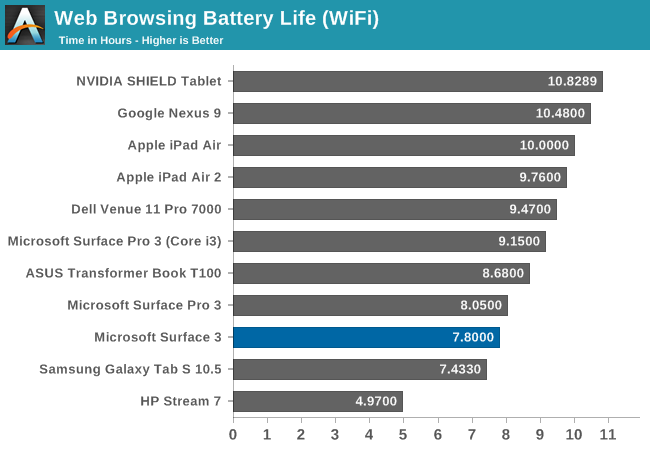
Compared to other tablets, the Surface 3 has pretty poor battery life. On our web browsing test, the Surface 3 came in at just under eight hours. The iPad Air 2 has a similar size battery, but manages almost two hours more battery life in this test. The CPU workload is fairly light in this test, but without a complete breakdown of all of the parts inside it would be difficult to pinpoint exactly what is the issue here.
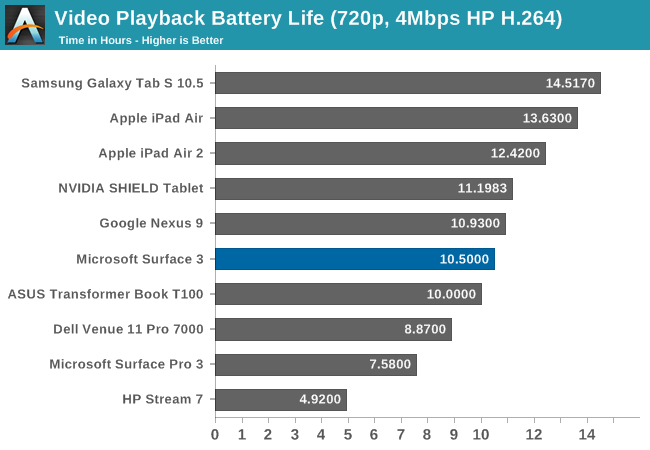
Update: May 18, 2015
After some discussions with Intel, I discovered that the battery life while playing back video was lower than it should be. Further digging into this issue found that the script being used to log the battery life time affected the tablet video playback test dramatically and resulted in much worse battery life result than was warranted. I have re-run this test several times with no script and was able to achieve 10.5 hours at 200 nits which is a much more respectable result. Further testing determined that this only affected the video playback times, and the other results were unchanged whether the script was running or not.
When this review was first published, we had tested the battery life at 7.72 hours of video playback. Upon subsequent research, it was determined that part of our logging in our battery life test caused an issue for unexpected CPU usage outside of the video decoder, and as a result, we are realigning the result to 10.5 hours. The issue in our test, based on retests of other devices, is currently only limited to the Surface 3 and specifically only to the video playback test.
On the video playback, the Surface 3 stumbles even farther, although the overall battery life is almost identical to the web browsing test. On the video playback many tablets are able to offload the work to hardware. Once again, without being able to check each part of the tablet individually it is not very easy to determine what is causing this weak battery life result.
So compared to tablets, the Surface 3 is about mid-pack in the video playback tests, and below average for web browsing. I hoped for a better result.
Laptop Battery Life
We have a different set of tests for notebook computers, so I also ran the Surface 3 through our light workload which is a different browser test.
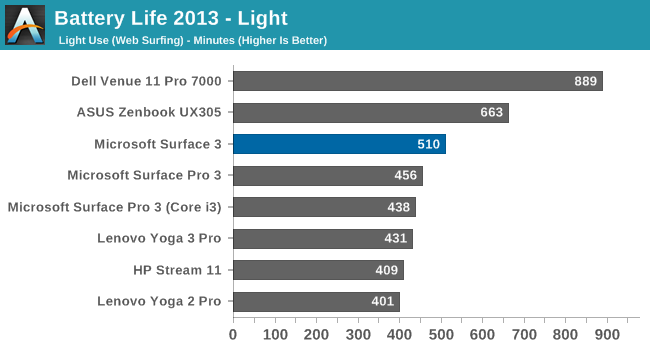

The Surface 3 manages to outperform the Surface Pro 3 here, and at 8.5 hours on our light test, it is a decent result.
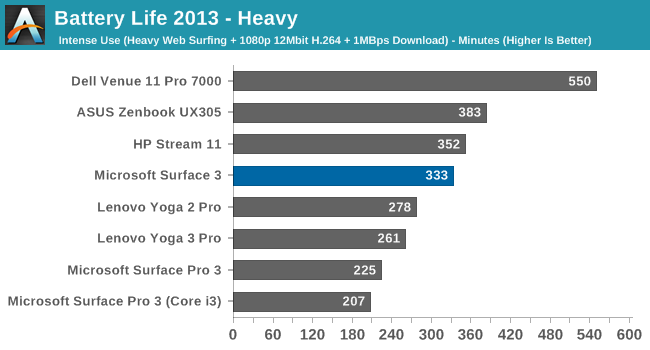
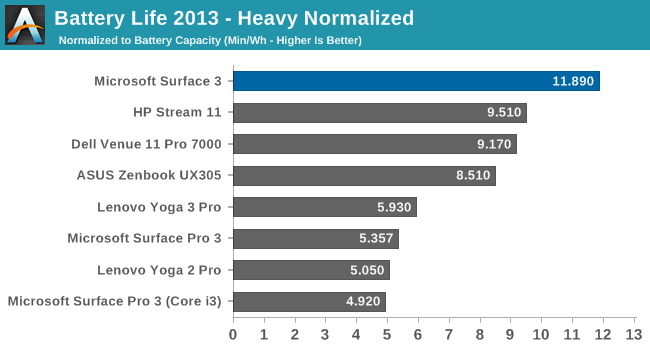
The situation is very similar under our heavy test. The Surface 3 once again outperforms the Surface Pro 3 here, however now it's by quite a bit more than it did under the Light test. Meanwhile compared to the Core M devices, only the Venue 11 remains well in the lead; the UX305's lead is down to 15%. Ultimately with a 2W SDP, the bulk of the Surface 3's power consumption is in the display, so ramping up for our heavy test does not have the same impact on overall power consumption as it does on devices with more powerful SoCs/CPUs. Meanwhile the situation also sees the Surface 3 do well on a normalized basis, well ahead of any other device with respect to the number of minutes of runtime per watt-hour of battery capacity.
Charge Time
The other aspect of mobility is charge time. Although longer battery life would always be a priority, the ability to quickly top up a device can make it a lot more useful in the real world where you are not always away from an outlet.
Charging time is always going to be a function of the battery size and the supplied charger’s ability to fill that battery. In the case of the Surface 3, Microsoft has shipped it with just a 13 watt charger, and when it is charging, only about half of that is available to the battery with the rest designated to power the system.
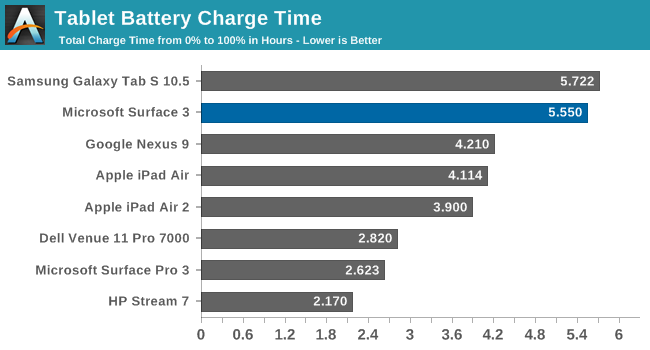
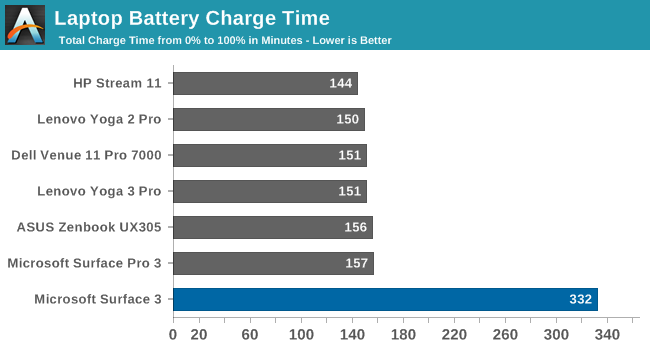
Compared to notebook computers, the charging time is quite a bit longer than we are used to seeing. The Surface Pro 3’s proprietary charging connector was able to charge quite quickly, but the Surface 3 is really quite slow. Part of this comes down to the micro USB connector which is now the charging connector.
This connector is just not built for the high amperage needed to quickly charge a device up. Although I am happy to see Microsoft ditch the previous charging connector, this is where a USB Type-C connector would be much better. It can handle a lot more power, and it would have allowed the Surface 3 to come with a much higher wattage adapter. It really feels a bit like putting one foot in the past with the micro USB port. The long charge times were quite an issue for me trying to review this device, since we run our battery life tests multiple times to ensure a reliable result, but there was a very long wait to get the device ready for another run.


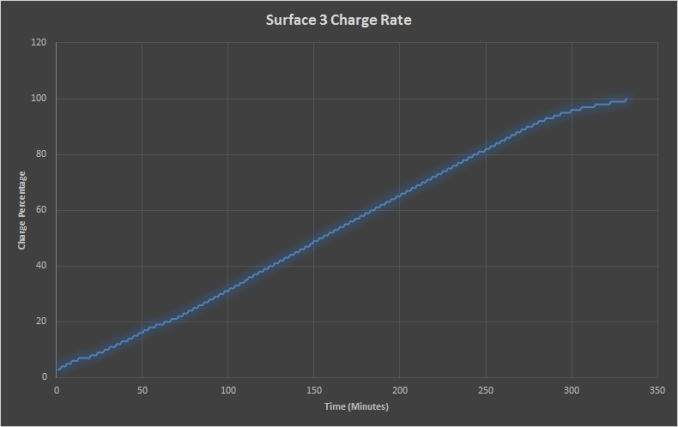








265 Comments
View All Comments
asfletch - Wednesday, May 6, 2015 - link
Reading and re-reading this review leads me to one conclusion - the Dell Venue Pro 11 7140 is a superb piece of engineering (if not design) and would be my ideal tablet, if not for the accursed 16:9 screen. It's also a deal-breaker on the T300 Chi. I guess I'm hanging out for a Core M SP4 (although I would prefer a slightly smaller tablet). Oh well.serendip - Wednesday, May 6, 2015 - link
Maybe I'm crazy... I use a Lenovo Miix 2 8" tablet with the older Bay Trail Z3740 as my main computing device and it's been good enough for more than a year. Office documents open fine, I can even run Linux VMs (mainly console stuff), the battery lasts 9 hours and with a portable keyboard, I have my office in under 800 grams.I paid a lot less than the Surface 3's price though. At $499, the Surface 3 is overpriced and the dock pricing is outrageous.
beggerking@yahoo.com - Wednesday, May 6, 2015 - link
mix 2 8" is great, but this is a 10-11".$499 is a bit high (should be sold for $299-399) but the build-in kickstand along..believe it or not, is so important that its actually worth the extra $100...
Yes i have Dell Venue 8, Miix 2, and insignia 8" and they all run great with 1-2 gb of ram and battery lasts forever, all cost < $250
accessories are always overpriced for any model.
Luc K - Thursday, May 7, 2015 - link
The Miix 2 10" actually also started at $499 (you see now discounts since it's > 1 year old device with last gen slower Atom CPU).domski - Wednesday, May 6, 2015 - link
How is pixel density related to backlight power consumption? The article implies the two are connected, but I don't see how.For an LCD, backlight power is usually just directly proportional to screen area and brightness. The pixel density may affect power consumption of the GPU and LCD driver hardware, and maybe also the liquid crystal matrix itself.
Is author (Brett Howse) mistaken? If not, can someone enlighten me about the connection between backlight power and pixel density?
Brett Howse - Wednesday, May 6, 2015 - link
I'm going to pull in a quote from another article which sums it up nicely:"The increase in number of pixels (and transistors powering the display—one for each RGB subpixel) comes with a corresponding increase in the percentage of light being blocked by the transistors and filaments. Thus, the percentage transparent area for each pixel is lower, necessitating a significantly stronger backlight when pixel density is increased."
http://www.anandtech.com/show/5688/apple-ipad-2012...
Brett Howse - Wednesday, May 6, 2015 - link
Also this is one of the advantages of IGZO TFTs is that the actual TFT (Thin Film Transistor) http://en.wikipedia.org/wiki/Thin-film_transistor is less opaque, so more light gets through as compared to Amorphous Silicon TFTs which are the standard (and cheaper) way they are done.buevaping - Wednesday, May 6, 2015 - link
I looked at the Surface 3 at the store today. The sales guy and I were shaking are heads about entry level specs with 2 gigs of ram. "Why doesn't the Windows button not work?" "Oh It probably needs to be shut down and restarted." I don't need a touch device that badly.Luc K - Thursday, May 7, 2015 - link
You can disable the Windows button in the surface app. Not sure why you say 2 GB is major issue. Did you see any issues? Lots of tablets with Atom have 2 GB running 8.1.domboy - Thursday, May 7, 2015 - link
Thank you for the wonderful review. While it makes sense to compare the Surface 3 to current product offerings, especially the Pro 3, I am slightly disappointed that there is not much in the way of comparison to the products it replaces - the Surface RT/2. I realize most of the benchmarks won't run on Windows RT, but the web browser tests and the store version of 3DMark could have been run, as well as some sort of battery life comparison. I'm going to assume that perhaps this is because you don't have older Surface models on hand, but I know this data has been gathered in the past and I think it might have been helpful to include for Surface RT/2 owners that may be considering upgrading.I do think it's a compelling product just to get proper pen support and x86 compatibility, though the RT jailbreak went a long way for me to be able to live with the original Surface RT which is what this would replace in my case. I do know the Asus T100 is faster than the original Surface RT, but I don't know how it compares to the Surface 2 speed-wise.